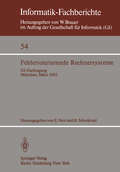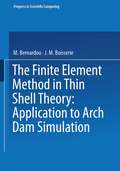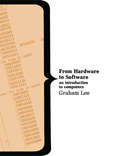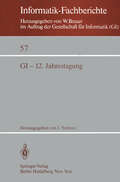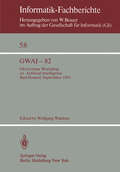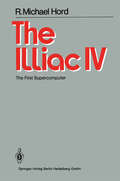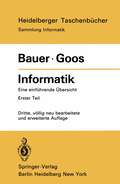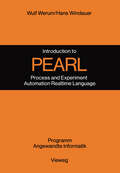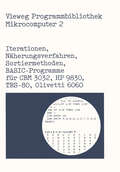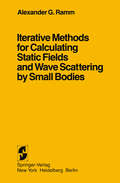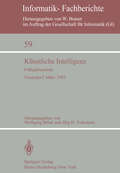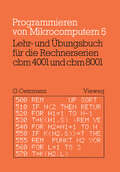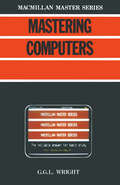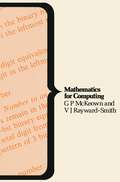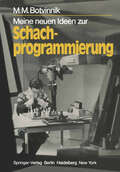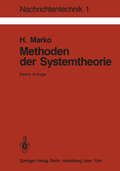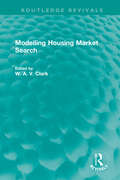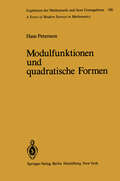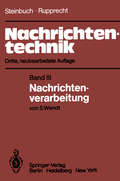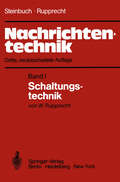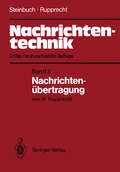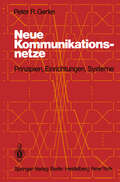- Table View
- List View
Fehlertolerierende Rechnersysteme: GI-Fachtagung München, 11.–12. März 1982 Gemeinsam veranstaltet von GI-Fachausschuß 8 und Fachausschuß 11 und GMD-Institut für Rechner- und Programmstrukturen, Siemens AG (Informatik-Fachberichte #54)
by E. Nett Heinz SchwärtzelThe Finite Element Method in Thin Shell Theory: Application to Arch Dam Simulations (Progress in Scientific Computing #1)
by Bernardou Boisserie~his Monograph has two objectives : to analyze a f inite e l e m en t m e th o d useful for solving a large class of t hi n shell prob l e ms, and to show in practice how to use this method to simulate an arch dam prob lem. The first objective is developed in Part I. We record the defi- tion of a general thin shell model corresponding to the W.T. KOlTER linear equations and we show the existence and the uniqueness for a solution. By using a co nform ing fi nite e l e m ent me t hod , we associate a family of discrete problems to the continuous problem ; prove the convergence of the method ; and obtain error estimates between exact and approximate solutions. We then describe the impl em enta t ion of some specific conforming methods. The second objective is developed in Part 2. It consists of applying these finite element methods in the case of a representative practical situation that is an arc h dam pro b le m. This kind of problem is still of great interest, since hydroelectric plants permit the rapid increase of electricity production during the day hours of heavy consumption. This regulation requires construction of new hydroelectric plants on suitable sites, as well as permanent control of existing dams that may be enlightened by numerical stress analysis .
GI-12. Jahrestagung: Kaiserslautern, 5.–7. Oktober 1982 Proceedings (Informatik-Fachberichte #57)
by J. NehmerDie 12. Jahrestagung der Gesellschaft für Informatik an der Univer sität Kaiserslautern steht unter dem thematischen Schwerpunkt nSYSTEMS ENGINEERING" in der Informatik. Unter dem Druck einer sehr geringen Zahl einge reichter Beiträge sind wir von dem Konzept der Vorjahre abgerückt, die Tagung überwiegend aus eingereichten Beiträgen zu bestreiten. Der zweite Tag hat durch die eingeladenen tfbersichtsvorträge einen vor wiegend tutorialen Charakter und soll der Jahrestagung gegenüber den vielen Fachtagungen eine eigenständige Attraktivität verleihen. Die in tfbersichtsvorträgen behandelten Themen sollen den hier anwesenden Fachleuten Gelegenheit bieten, sich bequem über außerhalb des eigenen Arbeitsgebiets sich abzeichnende neue Entwicklungen zu informieren. Dem Programmkomitee, den Programmausschüssen der Fachgespräche sowie dem Organisationskomitee am Tagungsort sei an dieser Stelle für ihren Beitrag zum Gelingen der Tagung herzlich gedankt. Kaiserslautern, Juli 1982 Jürgen Nehmer FOLGENDE FIRMEN HABEN DIE VORBEREITUNG UND AUSRICHTUNG DER TAGUNG FINANZIELL UNTERSTÜTZT: SIEMENS AG IBM DEUTSCHLAND GMBH BASF AG BROWN, BOVERI & CIE. AG TELEFONBAU & NORMALZEIT GMBH GEBR. KITTELBERGER GMBH & CO.
GWAI-82: 6th German Workshop on Artificial Intelligence Bad Honnef, Sept. 27. – Oct. 1, 1982 (Informatik-Fachberichte #58)
by W. WahlsterThe Illiac IV: The First Supercomputer
by R.M. HordThe Illiac IV was the first large scale array computer. As the fore runner of today's advanced computers, it brought whole classes of scientific computations into the realm of practicality. Conceived initially as a grand experiment in computer science, the revolutionary architecture incorporated both a high level of parallelism and pipe lining. After a difficult gestation, the Illiac IV became operational in November 1975. It has for a decade been a substantial driving force behind the develooment of computer technology. Today the Illiac IV continues to service large-scale scientific aoolication areas includ ing computational fluid dynamics, seismic stress wave propagation model ing, climate simulation, digital image processing, astrophysics, numerical analysis, spectroscopy and other diverse areas. This volume brings together previously published material, adapted in an effort to provide the reader with a perspective on the strengths and weaknesses of the Illiac IV and the impact this unique computa tional resource has had on the development of technology. The history and current status of the Illiac system, the design and architecture of the hardware, the programming languages, and a considerable sampling of applications are all covered at some length. A final section is devoted to commentary.
Informatik: Eine einführende Übersicht Erster Teil (Heidelberger Taschenbücher #80)
by F. L. Bauer Gerhard GoosIntroduction to PEARL: Process and Experiment Automation Realtime Language Description with Examples (Sammlung Vieweg)
by Wulf WerumIterationen, Näherungsverfahren, Sortiermethoden: BASIC-Programme für CBM 3032, HP 9830, TRS-80, Olivetti 6060 (The Wadsworth & Brooks/Cole Statistics/Probability Series)
by Harald SchumnyIterative Methods for Calculating Static Fields and Wave Scattering by Small Bodies
by Alexander G. RammIterative methods for calculating static fields are presented in this book. Static field boundary value problems are reduced to the boundary integral equations and these equations are solved by means of iterative processes. This is done for interior and exterior problems and for var ious boundary conditions. Most problems treated are three-dimensional, because for two-dimensional problems the specific and often powerful tool of conformal mapping is available. The iterative methods have some ad vantages over grid methods and, to a certain extent, variational methods: (1) they give analytic approximate formulas for the field and for some functionals of the field of practical importance (such as capacitance and polarizability tensor), (2) the formulas for the functionals can be used in a computer program for calculating these functionals for bodies of arbitrary shape, (3) iterative methods are convenient for computers. From a practical point of view the above methods reduce to the cal culation of multiple integrals. Of special interest is the case of inte grands with weak singularities. Some of the central results of the book are some analytic approximate formulas for scattering matrices for small bodies of arbitrary shape. These formulas answer many practical questions such as how does the scattering depend on the shape of the body or on the boundary conditions, how does one calculate the effective field in a medium consisting of many small particles, and many other questions.
Kontextsicherung in computergestützten Personalinformationssystemen (Linzer Universitätsschriften #8)
by M. PilsPraxis und Wissenschaft halten nach neuen Miiglichkeiten Ausschau, um die sich immer weiter entwickelnde Computertechnologie In zunehmendem MaBe such fOr die Personalarbeit In Unternehmungen und offentIichen Verwalt~ngen einzusetzen. Man blickt hierbei insbesondere auf die groBere Anzahl von personenbezogenen Daten, die in den meisten Betrieben iiber jeden Arbeitnehmer vorliegen und die sich im Verlaufe des Dlenstverhiiltnisses in den Personalakten oder an sonstigen Stellen im Betrieb angesammelt haben: Bewerbungsunterlagen, Zeugnlsse, Angaben iiber Krankenstiinde, Mitarbeiterbeurteilungen, Ergebnisse psychologischer Tests, um nur einige Miiglich keiten zu nennen. Verstiirkt befaBt man sich in letzter Zeit mit Fragen, wie man nicht nur fiir die Personalabrechnung, sondern auch fOr die Planung des Personalbedarfes, fOr das Beschaffen und Einsetzen von Mitarbeitern oder such fiir die Aus-und Weiterblldung, also fiir die gerade in der heutigen Zeit brennenden Probleme der betrieblichen Personalarbeit, eine Computerunterstiitzung planen sollte. Personalinformationssysteme liegen im Schnittpunkt sich teilweise erheblich wider sprechender Interessen. Der Autor legt Wert auf die Feststellung, daB L6sungen auf diesem Gebiet nur im Einvernehmen mit siimtlichen Betroffenen (Unternehmenslel tung, Benutzer, Arbeitnehmer und deren Vertreter usw. ) sinnvoll sein werden. Dieser Gedanke zieht sich wie ein roter Faden durch dieses Buch, ebenso wie die Prioritiiten setzung der Ziele der Systemgestaltung (Humanisierungsstreben rangiert vor Wirt schaftIichkeitsstreben, letzteres vor der technologlschen Realisierbarkeit). Der Autor vertritt seit Jahren eine kritische HaItung gegeniiber der Speicherung personenbezo gener Daten; als einer der ersten ist er bereltli vor Jahrengegen jedes einseitige Automatisierungsstreben im Bereich der Personalarbeit eingetreten.
Künstliche Intelligenz: Frühjahrsschule Teisendorf, 15.–24. März 1982 (Informatik-Fachberichte #59)
by Wolfgang Bibel Jörg SiekmannLehr- und Übungsbuch für die Rechnerserien cbm 4001 und cbm 8001 (Programmieren von Mikrocomputern)
by Gerhard OetzmannMeine neuen Ideen zur Schachprogrammierung (Informationstechnik und Datenverarbeitung)
by M. M. BotvinnikIn diesem Buch darf ich erstmals in deutscher Sprache umfassend und aktuell meine Ar beit an Grundlagen und Realisierung eines Computer-Schachprogramms vorstellen. Seit nunmehr gut zehn Jahren bemühen sich meine Mitarbeiter und ich um die Verfolgung eines anderen Ansatzes bei der Schachprogrammi erung als fast alle übri gen "Konkurrenten" der Wel t. Der intellektuelle Streit entzündet sich an der Fragestellung, ob vorrangig Schnellig keit, Speichergröße und Zuverlässigkeit von Rechnern auszunutzen seien, oder die Mo dellierung menschlicher Denkweisen beim Schachspielen angestrebt werden soll. Während die meisten Kollegen in aller Welt die erste Meinung vertreten und mit den nach der sogenannten "brute-force"-Methode spielenden Programmen auch erstaunliche Erfolge er zielen konnten, bin ich mit wenigen anderen Kritikern der Meinung, daß nur der zweite Ansatz auf Dauer die Spielstärke der Programme entscheidend verbessern kann. Natürlich gehen wir den weitaus schwereren Weg bei der Realisierung, denn die theore tischen Grundlagen und die notwendigen Programmsysteme sind um vieles komplexer. So mit müssen wir einen langen Atem beweisen und nicht um kurzfristiger Scheinerfolge willen das große Ziel gefährden. Ich bin aber sehr froh, daß inzwischen auch unsere Programmierung weitgehend abgeschlossen ist, und unser Programm "PIONI ER" erste prak tische Erfolge bei der Lösung von Studien nachweisen kann. Daher wird dieses Buch gerade zum richtigen Zeitpunkt erscheinen. Im Hauptteil dieses Werkes habe ich die allgemeinen Grundlagen ausführlich dargestellt, die für die Konzeption eines Schachprogramms, aber auch verwandter Problemstellungen notwendig sind.
Methoden der Systemtheorie: Die Spektraltransformationen und ihre Anwendungen (Nachrichtentechnik #1)
by Hans MarkoModelling Housing Market Search (Routledge Revivals)
by W. A. V. ClarkOriginally published in 1982, this book contains research in the area of econometric modelling in the housing market, including that which has extended to the use of search models. The subjects covered include the importance of racial differences, spatial aspects of residential search and information provision and its effect on the behaviour of the buyers. The combination of careful analytic modelling, empirical testing and speculative discussions of the role of agents in the search process provides an innovative and imaginative approach to the interesting problems of understanding the individual behaviour in complex contexts such as the urban housing market.
Modelling Housing Market Search (Routledge Revivals)
by William A. V. ClarkOriginally published in 1982, this book contains research in the area of econometric modelling in the housing market, including that which has extended to the use of search models. The subjects covered include the importance of racial differences, spatial aspects of residential search and information provision and its effect on the behaviour of the buyers. The combination of careful analytic modelling, empirical testing and speculative discussions of the role of agents in the search process provides an innovative and imaginative approach to the interesting problems of understanding the individual behaviour in complex contexts such as the urban housing market.
